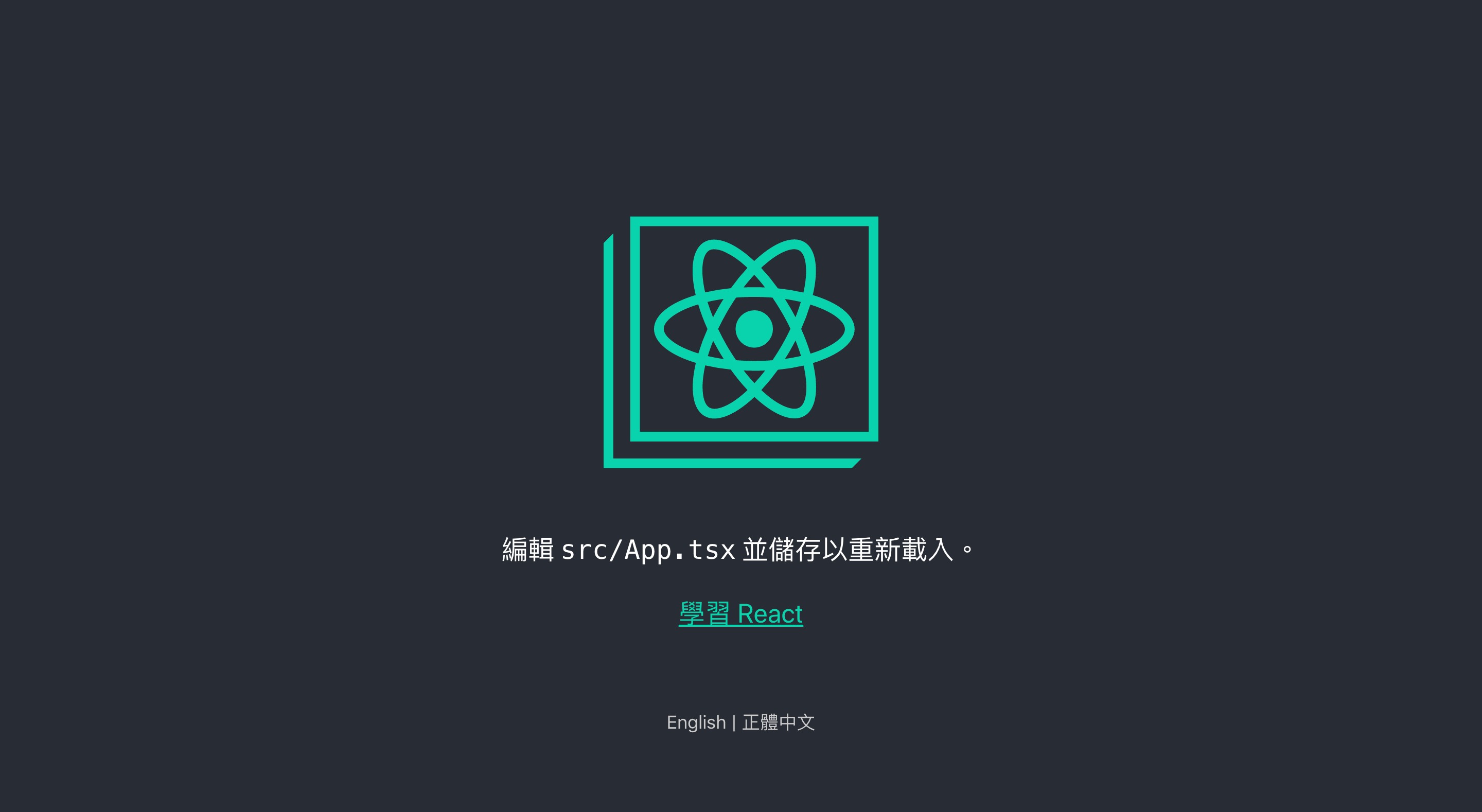
本文透過實現一個簡易的 i18n (internationalization) 功能來演示 React Context API 的基本應用。
React Context API
React Context 提供 component tree 傳遞資料的方法,而不必在每個級別傳遞 props。這很適合用在對於 React 應用程式中是屬於全域的資料,例如當前認證的用戶、主題或語言偏好。
較早版本的 React 提供的 Context API 官方並不建議使用。React 16.3 發布的 New Context API 使用 Render Props pattern 實現將資料傳遞給 children。
React 16.3+ Context API 核心包含:React.createContext、Context.Provider、Context.Consumer。
React.createContext
1
| const MyContext = React.createContext(defaultValue);
|
React.createContext 用於建立一個 Context 物件,該物件包含 Provider 和 Consumer 兩個 component。
Context.Provider
1
| <MyContext.Provider value={}>
|
Context.Provider 提供 context 的值,通常會放在 component tree 接近最上層的位置。
Context.Consumer
1
2
3
| <MyContext.Consumer>
{value => }
</MyContext.Consumer>
|
Context.Consumer 接收 context 的值,可以在屬於 Provider 子元件的任何一層使用。
使用 Context API 實現 i18n 功能
接下來會以實作 i18n 功能的例子說明如何使用 React Context API。我們以 Create React App 快速建立一個 React 應用程式範例,並建立 src/i18n 目錄。
I18nContext
我們使用 React.createContext 建立一個 I18nContext 及定義其初始狀態。這裡我們預計會提供三種方法來預計來實現多國語言轉換功能:
t(key: string): string: 將定義的鍵值翻譯成對應的語系內容getLocale(): 取得當前語系setLocale(): 設置/變更當前語系
1
2
3
4
5
6
7
8
9
| import { createContext } from 'react';
const I18nContext = createContext({
t: () => '',
getLocale: () => {},
setLocale: () => {},
});
export default I18nContext;
|
I18nProvider
所以我們需要實作一個 I18nProvider 在 tree 的上層使用來提供 context 的值:
1
2
3
4
5
6
7
8
9
10
11
12
13
14
15
16
17
18
19
20
| import React, { useState } from 'react';
import I18nContext from './I18nContext';
const I18nProvider = (props) => {
const [ locale, setLocale ] = useState('en-US');
const i18n = {
t: key => props.translations[locale][key],
getLocale: () => locale,
setLocale: locale => setLocale(locale),
};
return (
<I18nContext.Provider value={i18n}>
{props.children}
</I18nContext.Provider>
);
};
export default I18nProvider;
|
useI18n
為了讀取 context 及訂閱變更的內容,我們實作一個 useI18n 的 React hook 方便我們在其他 functional component 使用多國語言。我們使用 useContext 接收 I18nContext 取得當前 context 的狀態:
1
2
3
4
5
6
7
8
9
| import { useContext } from 'react';
import I18nContext from './I18nContext';
function useI18n () {
const i18n = useContext(I18nContext);
return i18n;
}
export default useI18n;
|
withI18n
自 React 16.8 Hooks 功能釋出後,functional component 已經可以藉用 useState 與 useEffect 等 hooks 滿足大部分情境。如果要使用傳統的 class component 時,我們可以實作一個 HOC (higher-order component) 來包裝 Context API 來使用 i18n:
1
2
3
4
5
6
7
8
9
10
11
12
13
14
15
| import React from 'react';
import I18nContext, { I18nContextProps } from './I18nContext';
export const withI18n = () => {
return WrappedComponent => {
const ComponentWithI18n = props => (
<I18nContext.Consumer>
{i18n => <WrappedComponent {...i18n} {...props} />}
</I18nContext.Consumer>
)
return ComponentWithI18n
}
};
export default withI18n;
|
最後在 src/i18n/index.js 將各個模組導出,方便在其他檔案中 import 它們。
1
2
3
| export { default as I18nProvider } from './I18nProvider';
export { default as useI18n } from './useI18n';
export { default as withI18n } from './withI18n';
|
在 React 中使用 I18nContext
接著可以在 React 應用程式使用我們建立好的 I18nContext 提供多國語言功能了。我們需要建立多個語系檔來決定轉譯的內容,在 src/locales 是我們要放置各語系檔案的目錄。以下以英文及中文為例:
src/locales/en-US.js
1
2
3
4
| export default {
'getting_started': 'Edit <code>src/App.tsx</code> and save to reload.',
'learn_react': 'Learn React',
};
|
src/locales/zh-TW.js
1
2
3
4
| export default {
'getting_started': '編輯 <code>src/App.tsx</code> 並儲存以重新載入。',
'learn_react': '學習 React',
};
|
在 React 應用程式入口 src/index.js,在 component tree 的上層引入 I18nProvider,並將語言包內容注入 Provider:
1
2
3
4
5
6
7
8
9
10
11
12
13
14
15
16
17
18
19
| import React from 'react';
import ReactDOM from 'react-dom';
import './index.css';
import App from './App';
import * as serviceWorker from './serviceWorker';
import { I18nProvider } from './i18n';
const locales = [ 'en-US', 'zh-TW' ];
const translations = {
'en-US': require('./locales/en-US').default,
'zh-TW': require('./locales/zh-TW').default,
}
ReactDOM.render(
<I18nProvider locales={locales} translations={translations}>
<App />
</I18nProvider>,
document.getElementById('root')
);
|
然後在需要使用多國語言的 functional component 引入 useI18n hook 使用 t 函式來轉換對應的語系內容,setLocale 用來設置轉換語系:
1
2
3
4
5
6
7
8
9
10
11
12
13
14
15
16
17
18
19
20
21
22
23
24
25
26
27
28
29
30
31
32
| import React from 'react';
import logo from './logo.svg';
import './App.css';
import { useI18n } from './i18n';
const App: React.FC = () => {
const { t, setLocale } = useI18n();
return (
<div className="App">
<header className="App-header">
<img src={logo} className="App-logo" alt="logo" />
<p dangerouslySetInnerHTML={{ __html: t('getting_started') }} />
<a
className="App-link"
href="https://reactjs.org"
target="_blank"
rel="noopener noreferrer"
>
{t('learn_react')}
</a>
</header>
<footer className="App-Footer">
<span className="App-Locale" onClick={() => setLocale('en-US')}>English</span>
{' | '}
<span className="App-Locale" onClick={() => setLocale('zh-TW')}>正體中文</span>
</footer>
</div>
);
}
export default App;
|
最後執行 npm start 查看結果。

總結
透過 React Context API 可以在 component 之間共享數據,結合 React Hook 與 HOC 可以很容易實現可複用的第三方 library。我們經由一個簡易的 i18n 功能展示如何使用它們,完整的範例可以參考 react-i18n-example。

